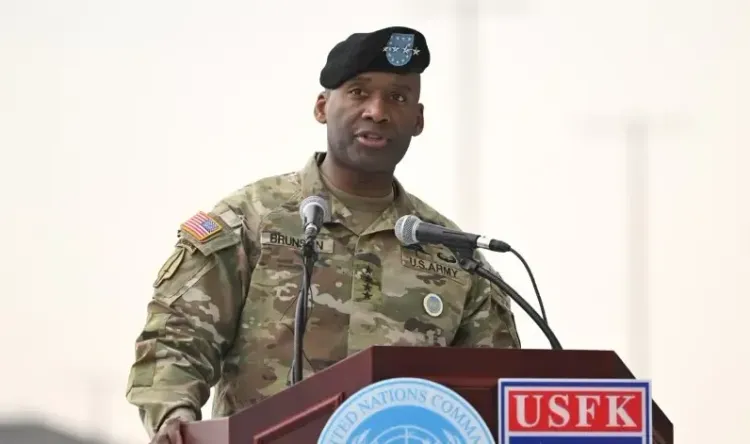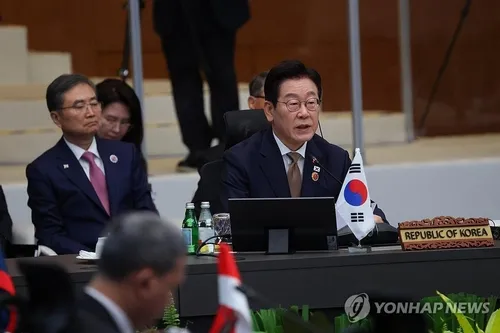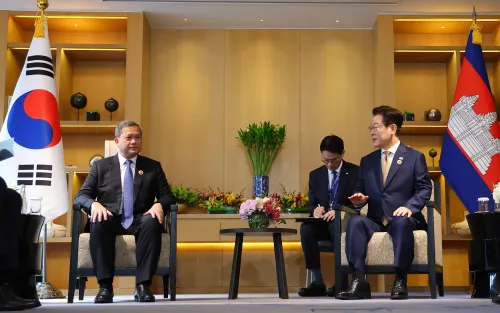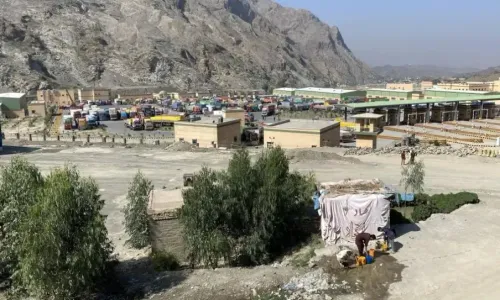United States and South Korea Forge New Wartime Contingency Strategy in Response to Rising North Korean Threats

Synopsis
Key Takeaways
- South Korea and the US signed a new joint wartime operations plan in response to North Korean threats.
- The new plan enhances readiness against North Korea's evolving military capabilities.
- Collaboration between the US and South Korea is crucial for regional stability.
- Investment by South Korea supports US military efforts and economic growth.
- The UN Command plays a vital role in maintaining peace in the region.
Seoul, April 10 (NationPress) South Korea and the United States finalized a new collaborative wartime operations strategy (OPLAN) last year to address the evolving military threats from North Korea, according to the commander of US Forces Korea (USFK).
Gen. Xavier Brunson made these comments in a written statement to the House Armed Services Committee on Wednesday, highlighting the strengthened security collaboration between Seoul and Washington to confront the escalating nuclear and ballistic missile dangers posed by North Korea. He also commands the South Korea-US Combined Forces Command (CFC) and UN Command (UNC).
"Last year, we took a significant step forward in our combat readiness when the new combined Operations Plan was signed," Brunson stated.
He noted, "Alliance planners have worked tirelessly over the years to develop this plan, consistently testing and validating its concepts through execution during our biannual Freedom Shield and Ulchi Freedom Shield exercises."
The new OPLAN, reportedly designated as "OPLAN 5022," is believed to have superseded OPLAN 5015. The earlier plan mainly focused on conventional North Korean assaults, which prompted calls for the South and the US to incorporate nuclear and other dimensions of North Korea's threats into their contingency strategy.
Brunson remarked that in light of North Korea's "increasingly sophisticated" weapons of mass destruction (WMD) and missile capabilities, the new OPLAN enhances CFC's preparedness ahead of potential conflict.
"We will persist in utilizing this plan, refining it, conducting exercises, and developing our operations, activities, and investments (OAIs) to support it," he explained. "As we continue to refine our exercise program in accordance with our new OPLAN, we seek further opportunities to improve integration and interoperability."
In December 2021, the defense chiefs of South Korea and the US approved Strategic Planning Guidance (SPG), which serves as a foundational document for updating or creating a new OPLAN, necessary to reflect advancements in North Korea's weaponry, including refined nuclear arms, hypersonic missiles, and submarine-launched ballistic missiles, according to reports from Yonhap news agency.
The previous SPG was based on the 2010 strategic guidance, which analysts deemed outdated considering it failed to account for the substantial progress Pyongyang has made in its relentless pursuit of new weapons, including intercontinental ballistic missiles (ICBMs).
In March 2022, the top generals of the allies signed the Strategic Planning Directive, a military document directing the revision of the Operational Control (OPCON) -- a crucial procedure designed to expedite the rewriting of contingency plans.
During a House committee hearing on the same day, Brunson emphasized the "positional advantage" of having American forces stationed on the Korean Peninsula, amid ongoing discussions about whether the Trump administration would consider a potential realignment or drawdown of USFK troops to focus more on challenges from China rather than North Korea.
"We should recognize that our organization and posture in the region do not require credit; however, we should acknowledge that we are positioned exactly where we need to be," he stated.
Brunson reiterated that the capabilities present within the Korean Theater of Operations (KTO) are appropriately situated.
He confirmed America's "unwavering" commitment to South Korea remains "steadfast," pointing out that North Korea's military advancements, including nuclear, biological, and nuclear weapons programs, along with "formidable" ballistic and cruise missile forces, pose a threat to the US mainland and its forces in the Indo-Pacific.
Highlighting the growing military alignment between Russia and North Korea, Brunson cautioned that Moscow's expanded cooperation is likely to facilitate advancements in Pyongyang's WMD program over the next three to five years.
He also indicated that his command anticipates North Korea will work towards achieving capabilities for hypersonic glide vehicles and multiple independently targetable reentry vehicles (MIRVs) in the coming year—advanced systems that many fear will significantly challenge the allies' missile defense efforts.
Describing the mutual defense treaty with Seoul as the "linchpin" for regional stability, the commander emphasized that the treaty "does not specifically name an adversary," suggesting that the alliance can take on a broader regional role beyond its traditional focus on North Korean threats.
"This fact is even more pertinent in today's strategic landscape, where authoritarian collusion presents evolving and growing threats to US and ROK interests in the region," he remarked. ROK is the abbreviation for South Korea's official name, the Republic of Korea.
Brunson also pointed out that American investments in South Korea's security have yielded positive returns.
"Economically, the ROK, bolstered by US strength, has grown to provide nearly 450,000 American jobs and host 2,100 US companies in both Korea and the United States," he stated. "Militarily, ROK contributions lower US costs by as much as 18 percent across all military expenditures."
He noted that South Korea contributes over $500 million annually to USFK's military construction needs and that Korean labor contributions supporting American military activities amount to around $412 million.
Additionally, Brunson emphasized the role of the UN Command in maintaining regional security.
"We are currently exploring the potential to continue partnering with others, like those in the UNC—comprising 18 nations—to strengthen our capacity in the region and demonstrate our resolve," he stated.
Established under a UN mandate to restore peace after the outbreak of the 1950-53 Korean War, the UNC now plays a vital role in monitoring the Armistice Agreement that ended the conflict. Seoul and Washington have agreed to expand their membership for enhanced regional security.
Brunson also highlighted the potential for South Korea's involvement in the US military's maintenance, repair, and overhaul (MRO) efforts.
"The ROK invests heavily in acquiring US defense technologies, enabling multi-domain interoperability in a dynamic security environment," he noted. "Consequently, the ROK is increasingly familiar with numerous major US platforms, which opens the possibility for MRO work."









